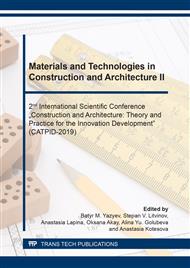[1]
Recommendations for designing the reinforcement of reinforced concrete structures of buildings and structures of reconstructed enterprises. Surface structures and structures, Kharkov Promstroyniiproekt, NIIZHB, Stroyizdat, Moscow, (1992).
Google Scholar
[2]
N.M. Snyatkov, D.S. Alekseev, Calculation of reinforced concrete elements, reinforced under load. Bulletin of Tambov State Technical University. 2 (2004) 556-566.
Google Scholar
[3]
D.S. Toshin, Application of the diagram method in the calculations of reinforced structures, Scientific Review. 1 (2016) 85-89.
Google Scholar
[4]
V.A. Eryshev, Energy Saving Model, Materials Science Forum. 931 (2018) MSF. 36-41.
Google Scholar
[5]
N.I. Karpenko. General models of reinforced concrete mechanics, Stroyizdat, Moscow (1996).
Google Scholar
[6]
N.I. Karpenko, B.S. Sokolov, O.V. Radaykin, Analysis and improvement of curvilinear diagrams of concrete deformation for the calculation of reinforced concrete structures according to the deformation model, Industrial and civil construction. 1 (2013) 25-27.
Google Scholar
[7]
N.I. Karpenko, V.N. Yarmakovsky, D.Z. Kadiev, Effect of concrete moisture on the diagrams of its deformation under load at low negative (up to -70 ° C) temperature, Building materials. 6 (2017) 10-13.
Google Scholar
[8]
N.I. Karpenko, V.A. Eryshev, V.I. Rimshin, International Multi-Conference, International Edition. Series IOP Conference Series: Materials Science and Engineering, 2018. p.032024.
DOI: 10.1088/1757-899x/463/3/032024
Google Scholar
[9]
I.T. Mirsayapov, I.S. Abdrakhmanov, Method of calculating the strength of normal sections of wood-reinforced concrete bent elements based on analytical diagrams of deformation of concrete and wood, News of Orel State Technical University. Series: Construction and Transportation. 3-15 (2007) 40-45.
Google Scholar
[10]
G.V. Murashkin, S.S. Mordovskiy, The use of deformation diagrams for calculating the bearing capacity of eccentrically compressed reinforced concrete elements, Housing. 3 (2013) 38-40.
Google Scholar
[11]
A.I. Nikulin, Method of calculating the load-carrying capacity of reinforced concrete elements of T-section, reinforced under load, News of Orel State Technical University. Series: Construction and Transportation. 1 (2006) 28-36.
Google Scholar
[12]
D.A. Panfilov, A.A. Pischulev, The methodology for calculating deflections of reinforced concrete beams exposed to short duration uniform loading (based on nonlinear deformation model), Procedia Engineering, XXIII R-S-P Seminar, Theoretical Foundation of Civil Engineering (23RSP) (TFoCE 2014) ISSN: 18777058, 91 (2014) 188−193.
DOI: 10.1016/j.proeng.2014.12.044
Google Scholar
[13]
A.A. Pishchulev, D.A. Panfilov, A.N. Aleshin, Evaluating the load-carrying ability of compressed reinforced concrete elements with heterogeneous strength properties of concrete, MATEC Web of Conferences Editors: S. Jemioło, A. Zbiciak, M. Mitew-Czajewska, M. Krzemiński and M. Gajewski. 2017. p.00136.
DOI: 10.1051/matecconf/201711700136
Google Scholar
[14]
O.V. Radaykin, On the construction of concrete deformation diagrams under uniaxial short-term tension/compression using the deformation criterion of damageability. Bulletin of Civil Engineers. 6 (65) (2017) 71-78.
Google Scholar


